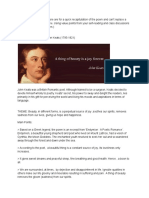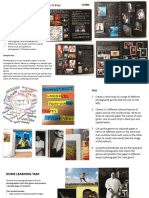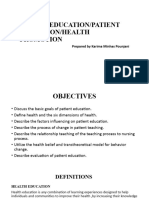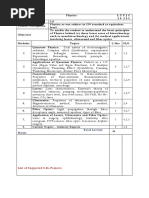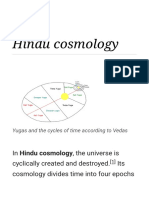A Thing of Beauty
A Thing of Beauty
Uploaded by
masood9a07sCopyright:
Available Formats
A Thing of Beauty
A Thing of Beauty
Uploaded by
masood9a07sCopyright
Available Formats
Share this document
Did you find this document useful?
Is this content inappropriate?
Copyright:
Available Formats
A Thing of Beauty
A Thing of Beauty
Uploaded by
masood9a07sCopyright:
Available Formats
A Thing of Beauty- by John Keats
Summary :
A Thing of Beauty is about appreciating anything and everything around us. Anything that looks beautiful
is a source of joy for us. A beautiful thing becomes more attractive as we keep enjoying it. The more we
look closely at its beauty, the more we discover its stunning features. We never forget a thing of beauty as
its memory is etched into our minds due to the joy and loveliness received from it. The after-effect of a
beautiful thing is that it will always prove to be a source of happiness and peace, just like a shade under a
tree or a sleep full of sweet dreams. Our lives, as a consequence, will be full of good health and peace.
Humans are connected to nature in a very close way. We participate in various earthly activities to keep
ourselves attached to mother nature. Bonding with nature around us has been compared to wreathing
flowery bands. There are many negative things in our lives, like dealing with hopelessness, encountering
people who are not kind or compassionate by nature and facing various immoral and inhuman activities
that lessen our belief in humanity. Despite acknowledging the presence of these things, a beautiful thing
never fails to uplift our moods. It makes us forget our worries and troubles away.
We can find beauty anywhere if we want to see it. We can find it in ordinary things around us like the sun,
the moon, trees or something as simple as a shade for sheep(simple sheep refers to ordinary human being).
The poet gives more examples to show the richness of beauty around us, like flowers, rills and the mid-
forest brake. He also points out that we can find beauty in places where we generally do not look, like the
reasons and circumstances behind the deaths of mighty heroes and warriors. Beauty exists in intangible
things like the stories that we read or hear.
The poet urges us to see the immense reserve of beauty around us. He calls it an ‘endless fountain of
immortal drink’: ‘endless’ because sources of beauty are limitless and ‘immortal’ to denote the effect of
beauty on our minds. The memory of a beautiful experience is forever. It never dies. We are blessed to
experience beauty in all forms around us. A direct reference to ‘heaven’ has been made to show that God
has provided us with many sources of beauty.
Rhyme scheme used: aa bb.
Figures of speech used
Alliteration: sleep full of sweet dreams,
band to bind,
noble natures,
such the sun ,
sprouting a shady boon for simple sheep
cooling covert
2. Metaphor.
wreathing a flowery band to bind us to the earth
sprouting a shady boon For simple sheep
An endless fountain of immortal drink
3. Enjambment : The continuation of lines without pause, creating a fluid
narrative flow.
– Throughout stanza 1( A thing of beauty…….breathing)
- Throughout stanza 2 ( Therefore on every morrow……..dark spirits)
- Throughout stanza 3 ( Such the sun the moon……….. forest brake)
- Throughout stanza 4 ( Rich with a …………… heaven’s brink)
4. Imagery:
– “A flowery band to bind us to the earth”
- Trees old, and young, sprouting a shady boon / For simple sheep; and such are
daffodils / With the green world they live in; and clear rills”
“Rich with a sprinkling of fair musk-rose blooms”
5. Personification
- That for themselves a cooling covert make” ( Giving human-like actions to
the rills, as they actively create a cooling cover.)
-,Pouring unto us from the heaven’s brink.”
[The act of pouring is attributed to an inanimate object (the fountain), giving it
human-like qualities.]
A Thing of Beauty- Question Answers
Q1. List the things of beauty mentioned in the poem.
Ans: Everything of nature is a thing of beauty and a source of pleasure. Some of them are:
the sun, the moon, old and young trees, daffodil flowers, small streams with clear water, mass
of ferns and the blooming musk-roses. All of them are things of beauty. They are a constant
source of joy and pleasure.
Q2. List the things that cause suffering and pain.
Ans: There are many things that cause us suffering and pain. Malice and disappointment are
“the biggest source of our suffering. Another one is the lack of noble qualities. Our unhealthy
and evil ways also give birth to so many troubles and sufferings. They dampen our spirits.
They act as a pall of sadness on our lives.
Q3. What does the line, ‘Therefore are we wreathing a flowery band to bind us to earth’
suggest to you?
Ans: Keats is a lover of beauty. He employs his senses to discover beauty. The link of man
with nature is eternal. The things of beauty are like wreaths of beautiful flowers. We seem to
weave a flowery band everyday. It keeps us attached to the beauties of this earth.
Q4. What makes human beings love life in spite of troubles and sufferings?
Ans: There are many things that bring us troubles and sufferings. They dampen our spirits.
However, ‘some shape of beauty1 brings love and happiness in our lives in spite of such
unpleasant things. A thing of beauty removes the pall of sadness and sufferings. It makes us
love life.
Q5. Why is ‘grandeur’ associated with the ‘mighty dead’?
Ans: The mighty dead were very powerful and dominating persons during their own times.
Their achievements made them ‘mighty’ and great. Their noble works dazzle our eyes. We
imagine that such mighty dead forefathers will attain more grandeur on the doomsday. Hence
‘grandeur’ is associated with the ‘mighty dead’.
Q6. Do we experience things of beauty only for short moments or do they make a lasting
impression on us?
Ans: We feel happy by coming into contact with things of beauty. They make a lasting
impression on us. Keats makes it clear at the outset. A thing of beauty is a joy forever. It is a
constant source of joy and pleasure. Its beauty never declines or diminishes. Its loveliness
goes on increasing every moment. Its value remains undiminished. It never passes into
nothingness. It removes the pall of sadness that covers our dark spirits.
Q7, What image does the poet use to describe the beautiful bounty of the earth?
Ans: John Keats uses a very beautiful image to describe the beautiful bounty of the earth. It is
the endless fountain of immortal drink. It pours constantly into our hearts from heaven. Thus,
the beautiful bounty of the earth is called “an endless fountain of immortal drink.”
Q8.What symbolism has been used in simple sheep ?
Answer: Simple Sheep alludes to ordinary people, and the
poet wishes to emphasize that nature does not discriminate
when it comes to raining its blessings...they are just as
readily available to the simple sheep as they are to those
who profess to have amassed vast wealth.
Sheep is also a sign of divinity in Christianity, as it is
thought that Jesus Christ was a shephered and surrounded
by a flock of sheep when he was crucified.
Reference to context:
A. “Therefore, on every morrow, are we wreathing …………….n spite of all,
(a)Name the poem and the poet.
(b)Why are we despondent?
(c)What removes the pall from our dark spirits?
(d) What are we doing every day?
Answers:
а)The poet is John Keats. The poem is A Thing of Beauty.
(b)We possess the evil qualities of malice and disappointment. We suffer from the lack of
noble qualities. That is why we feel despondent.
(c) Some beautiful shapes or a thing of beauty removes the pall of sadness from our hearts or
spirits.
(d) We are weaving a flowery wreath of beautiful memories which bind us to the earth.
B. “And such too is the grandeur of the dooms……………heaven’s brink”
a)Name the poetic device used in “ we have heard or read”.
(b)Explain: ‘the grandeur of the dooms’.
(c)What is the thing of beauty mentioned in these lines’?
(d)What image does the poet use in these lines?
Answers:
(а) Alliteration
(b)The magnificence that we imagine for our mighty dead forefathers on the dooms day.
(c)The lovely tales of mighty men are mentioned in these lines.
(d)The poet uses the image of ‘an endless fountain of immortal drink’ to describe the
beautiful bounty of the earth. The earth has bestowed us with sun, moon, flowers, rivers,
greenery etc.
You might also like
- How Designers Think - The Design Process DemystifiDocument12 pagesHow Designers Think - The Design Process DemystifiAnasHijazi0% (1)
- The Grace of Beauty: Its Mystery, Power and Delight in Daily LifeFrom EverandThe Grace of Beauty: Its Mystery, Power and Delight in Daily LifeNo ratings yet
- A Thing of BeautyDocument4 pagesA Thing of Beautyrajasveersingh2007No ratings yet
- A Thing of BeautyDocument5 pagesA Thing of Beautymahadevas1975No ratings yet
- A Thing of BeautyDocument5 pagesA Thing of BeautyAnanya RayNo ratings yet
- A Thing of BeautyDocument2 pagesA Thing of Beautyap6733702No ratings yet
- Thing of Beauty QnADocument3 pagesThing of Beauty QnAMIHIR NAYAKNo ratings yet
- A Thing of BeautyDocument3 pagesA Thing of BeautySameehaNo ratings yet
- 8336219-A Thing of Beauty-QB, 22Document4 pages8336219-A Thing of Beauty-QB, 22SatyamisLiveNo ratings yet
- A Thing of Beauty Questions and AnswersDocument10 pagesA Thing of Beauty Questions and AnswersPHANINDRA M100% (1)
- 2024 - 2025 Grade XII English Poem 3 A Thing of BeautyDocument9 pages2024 - 2025 Grade XII English Poem 3 A Thing of Beautyshatrudhan2007lkNo ratings yet
- Emailing A Thing of BeautyDocument6 pagesEmailing A Thing of Beautyradhikabathla8No ratings yet
- A Thing of Beauty 12thDocument4 pagesA Thing of Beauty 12thRakesh SinghNo ratings yet
- A Thing of Beauty - Questions and AnswersDocument3 pagesA Thing of Beauty - Questions and AnswersAdnan VPNo ratings yet
- Class12athingofbeautyDocument5 pagesClass12athingofbeautystudyalltime75055No ratings yet
- ATHINGOFBEAUTYDocument3 pagesATHINGOFBEAUTYCONCXPTNo ratings yet
- A Thing of BeautyDocument22 pagesA Thing of Beautyananttuli8416No ratings yet
- Notes,Poetic Devices of A thing of beauityDocument6 pagesNotes,Poetic Devices of A thing of beauity4788mishraNo ratings yet
- Flamingo (P- 4- A Thing of Beauty) (John Keats)Document4 pagesFlamingo (P- 4- A Thing of Beauty) (John Keats)dasgovindsingh1234No ratings yet
- A Thing of Beauty IMPORTANT Question AnswerDocument5 pagesA Thing of Beauty IMPORTANT Question AnswerjwjkekeiwhdudNo ratings yet
- Poem-4 A Thing of BeautyDocument7 pagesPoem-4 A Thing of BeautyZEUS GAMING100% (1)
- A Thing of BeautyDocument4 pagesA Thing of BeautyTjNo ratings yet
- A Thing of BeautyDocument4 pagesA Thing of BeautyrampriyachinNo ratings yet
- 12 - Poem - 4 - A Thing of BeautyDocument7 pages12 - Poem - 4 - A Thing of BeautyemshreeshivaniNo ratings yet
- CSK W A Thing of BeautyDocument5 pagesCSK W A Thing of BeautyAaron JoshiNo ratings yet
- A Thing Of BeautyDocument7 pagesA Thing Of Beautyracheltk9571No ratings yet
- A THING OF BEAUTY (1)Document6 pagesA THING OF BEAUTY (1)Nasreen AduvannyNo ratings yet
- A Thing of Beauty PoemDocument5 pagesA Thing of Beauty PoemAstha NNo ratings yet
- 12 English-AThing of Beauty-NotesDocument6 pages12 English-AThing of Beauty-Notesaryantejpal2605No ratings yet
- A Thing of BeautyDocument3 pagesA Thing of BeautySamranNo ratings yet
- A Thing of BeautyDocument7 pagesA Thing of BeautyETHIRAJNo ratings yet
- A Thing of BeautyDocument12 pagesA Thing of BeautyAkshat AgarwalNo ratings yet
- A Thing of Beauty-John KeatsDocument7 pagesA Thing of Beauty-John Keatsselectricbolt2No ratings yet
- Thing of BeautyDocument7 pagesThing of BeautykanakvermamailNo ratings yet
- A Thing F BeautyDocument4 pagesA Thing F BeautymnmzzNo ratings yet
- A Thing of BeautyDocument8 pagesA Thing of BeautyVarun KumarNo ratings yet
- Keats-A Thing of BeautyDocument9 pagesKeats-A Thing of BeautyAgastya KarnwalNo ratings yet
- A Thing of Beauty NotesDocument2 pagesA Thing of Beauty Noteslokeshelumalai38No ratings yet
- A Thing of Beauty Questions (1)Document4 pagesA Thing of Beauty Questions (1)rashikasingh1007No ratings yet
- A Thing of BeautyDocument4 pagesA Thing of BeautyNandita BaruahNo ratings yet
- Poem 4 A Thing of BeautyDocument8 pagesPoem 4 A Thing of BeautyJamesNo ratings yet
- A Thing of Beauty STUDENT NOTESDocument9 pagesA Thing of Beauty STUDENT NOTESAnanya JalanNo ratings yet
- a thing of beautyDocument2 pagesa thing of beautysunilkumarjd01No ratings yet
- A Thing of BeautyDocument3 pagesA Thing of Beautyfunnyid114No ratings yet
- XII - Notes - A Thing of Beauty - 2023 - 2024Document2 pagesXII - Notes - A Thing of Beauty - 2023 - 2024Hari prakarsh NimiNo ratings yet
- A Thing of Beauty Summary, Explanation, Reference To Context and Additional Questions and AnswersDocument5 pagesA Thing of Beauty Summary, Explanation, Reference To Context and Additional Questions and AnswersyenkhomkrishNo ratings yet
- A Thing of BeautyDocument3 pagesA Thing of Beautyg.srinivasaraoNo ratings yet
- A Thing of Beauty PoemDocument7 pagesA Thing of Beauty PoemDIVYJYOTI TVS, BHAGATUA, VARANASINo ratings yet
- A Thing of Beauty - Poem (Flamingo) - NotesDocument7 pagesA Thing of Beauty - Poem (Flamingo) - NotesPrince PandeyNo ratings yet
- Handout - Thing of BeautyDocument6 pagesHandout - Thing of BeautySAKSHAM NAGPALNo ratings yet
- A Thing of BeautyDocument6 pagesA Thing of Beauty2711.hbNo ratings yet
- 4244504-QB - A Thing of BeautyDocument5 pages4244504-QB - A Thing of Beautytrendsway05No ratings yet
- 261 Ki Va Ag PJM W0 JAGKW1643344363Document4 pages261 Ki Va Ag PJM W0 JAGKW1643344363ritvi PathakNo ratings yet
- Theme of The Poem:: A Thing of BeautyDocument6 pagesTheme of The Poem:: A Thing of BeautyArnav YadavilliNo ratings yet
- Flamingo, Poem-4 A Thing of BeautyDocument5 pagesFlamingo, Poem-4 A Thing of BeautyMohammad AyaanNo ratings yet
- A Thing of Beauty by John Keats - NewDocument11 pagesA Thing of Beauty by John Keats - Newfathima anzalaNo ratings yet
- A Thing of Beauty by JohnDocument6 pagesA Thing of Beauty by JohnMilena Ianigro75% (4)
- A Thing of BeautyDocument3 pagesA Thing of BeautyAbhishek nairNo ratings yet
- A Thing of Beauty - Docx - 20231101 - 215435 - 0000Document3 pagesA Thing of Beauty - Docx - 20231101 - 215435 - 0000k satyasreeNo ratings yet
- ZZZ12Document3 pagesZZZ12Saksham GoyalNo ratings yet
- In The Rue Bel Tesoro (Fragmented)Document1 pageIn The Rue Bel Tesoro (Fragmented)Zaque FransNo ratings yet
- Internship Report On Solar ProjectDocument29 pagesInternship Report On Solar ProjectSk.Abdul NaveedNo ratings yet
- GenreDocument4 pagesGenreapi-696280637No ratings yet
- Health EducationDocument26 pagesHealth EducationOnLY StuDYNo ratings yet
- BI Publisher E24217Document104 pagesBI Publisher E24217juancitorissolaNo ratings yet
- ANAPHY Lec Session #13 - SAS (Agdana, Nicole Ken)Document9 pagesANAPHY Lec Session #13 - SAS (Agdana, Nicole Ken)Nicole Ken AgdanaNo ratings yet
- Lessons Must Be Submitted As A Single .PDF File. Lessons 8, 18, and 26 Are ExaminationsDocument2 pagesLessons Must Be Submitted As A Single .PDF File. Lessons 8, 18, and 26 Are ExaminationsWillLow1No ratings yet
- Sig493 - Discourse Analysis - 02 - PragmaticsDocument27 pagesSig493 - Discourse Analysis - 02 - PragmaticsTasya Yushita100% (1)
- RPMS Portfolio: For Proficient TeachersDocument37 pagesRPMS Portfolio: For Proficient TeachersJuliet Macaraeg AñesNo ratings yet
- EUROPEANS AND THE KIKUYU TO 1910 - A STUDY OF - cIRcle (PDFDrive)Document218 pagesEUROPEANS AND THE KIKUYU TO 1910 - A STUDY OF - cIRcle (PDFDrive)Waruingi wa MwanikiNo ratings yet
- Tort MCQ'sDocument24 pagesTort MCQ'sRAHUL KUMARNo ratings yet
- Masters 2018 Recipe Peng Chieh WANG Artistic PieceDocument10 pagesMasters 2018 Recipe Peng Chieh WANG Artistic Piece2786 TuanphungNo ratings yet
- Jigjiga University. College of Business and Economics. Departmenets of Accounting and Finance. Batch 3 Year, 3 Semester. Jigjiga Week-End ProgramDocument2 pagesJigjiga University. College of Business and Economics. Departmenets of Accounting and Finance. Batch 3 Year, 3 Semester. Jigjiga Week-End ProgramOumer ShaffiNo ratings yet
- PHY1003 - PHYSICS - ETH - 1.0 - 0 - PHY1003 Physics PDFDocument4 pagesPHY1003 - PHYSICS - ETH - 1.0 - 0 - PHY1003 Physics PDFChandreyi ChowdhuryNo ratings yet
- The Living World - DPP 01 - Yakeen 2.0 2024 (Legend)Document3 pagesThe Living World - DPP 01 - Yakeen 2.0 2024 (Legend)raj52013214No ratings yet
- Theoretical Framework of The StudyDocument16 pagesTheoretical Framework of The StudyKurt CaneroNo ratings yet
- Module 5 Audit CISDocument4 pagesModule 5 Audit CISAnonymityNo ratings yet
- Hindu CosmologyDocument36 pagesHindu CosmologyShivam Kamboj0% (1)
- Aristotle Final Class Program-Teaching LoadsDocument5 pagesAristotle Final Class Program-Teaching LoadsAbegail PanangNo ratings yet
- Ehra2019 New Ecg Uses Signals From Ear and Hand To Check Heart Rhythm PDFDocument2 pagesEhra2019 New Ecg Uses Signals From Ear and Hand To Check Heart Rhythm PDFMARIA NATALIA MARTINSNo ratings yet
- RCA ListDocument2 pagesRCA ListAkash SrivastavaNo ratings yet
- B.SC., Physics: Sri Krishnadevaraya University:: AnantapuramuDocument15 pagesB.SC., Physics: Sri Krishnadevaraya University:: AnantapuramuHiNo ratings yet
- ReflectionDocument4 pagesReflectionShamaica SurigaoNo ratings yet
- LAS English G2 - Q3 - MELC No. 4 - Recognize The Difference Between Made Up Amd Real in Texts Listened To.Document9 pagesLAS English G2 - Q3 - MELC No. 4 - Recognize The Difference Between Made Up Amd Real in Texts Listened To.Alen CaldeoNo ratings yet
- Sample IADocument33 pagesSample IATareeke ThompsonNo ratings yet
- Assignment 1 CodeDocument7 pagesAssignment 1 Codeshivakalyan yadavNo ratings yet
- Jadwal Sma FD 2022-2023 Ganjil Soft SkillDocument6 pagesJadwal Sma FD 2022-2023 Ganjil Soft SkillSeptianNo ratings yet
- Trigeminal NerveDocument61 pagesTrigeminal NerveTanu ShreyaNo ratings yet
- Oakland County Brief Filed in MI Appeals CourtDocument100 pagesOakland County Brief Filed in MI Appeals CourtAnonymous dp5b3X1NANo ratings yet








































